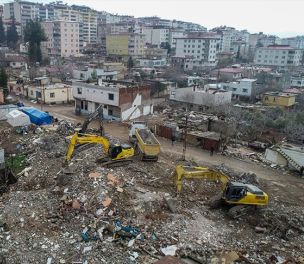Photo: AA/File
Click to read the article in Turkish
Among the 11 provinces directly affected by the February 6 earthquakes, Kilis was one of the provinces that suffered relatively less damage. The city with a population of 147,000 witnessed the collapse of 178 buildings and the loss of 74 lives.
Official data reveals that 3,312 residences, 262 commercial areas, 900 barns, and other structures experienced moderate to significant damage. There are no longer individuals residing in tents or accommodated in public facilities, while approximately 1,696 people remain in container cities located both in the urban center and rural areas.
CLICK - Special Series: Six Months on From Turkey Earthquakes
"People returned to damaged homes"
Halit Ünlükahraman, the head of the Chamber of Civil Engineers Kilis Branch, affirms the official information. However, he highlights that many people have chosen not to stay in containers and have returned to their damaged homes.
While Kilis suffered relatively less damage compared to other provinces directly impacted by the earthquake, after six months, Halit Ünlükahraman considers the situation precarious.
"While the demolition of a few buildings, which were already expected to collapse and posed a significant risk, has been carried out, the overall efforts remain inadequate," he says.
"There are still numerous moderately damaged buildings that require demolition. In some cases, structures classified as moderately damaged are redefined to slightly damaged through complaints and objections. The oversight and regulation of these matters are lacking.
"The local urban planning directorate proves insufficient. Should it oversee project bidding, handle applications, or inspect the sites? Our engineering colleagues in the field cannot meet all these demands.
"It is necessary to establish a comprehensive committee to thoroughly assess all aspects of the situation. A dedicated department within an organization to address earthquake concerns would greatly enhance efficacy."
Reconstruction
According to the Ministry of Environment, Urbanization and Climate Change, a total of 3,361 residential and village houses will be constructed in Kilis. The construction of 1,854 homes has already commenced, and bids have been awarded for 120 units.
Unlike many provinces where container cities are established on the outskirts, posing challenges for disaster survivors, Kilis differs as these temporary housing facilities are situated within the city. However, residents of the city are still reluctant to choose this option, according to Onur Kafalı, head of the Chamber of Urban Planners Adana Branch:
"On February 11, we prepared a reference document and put forward suggestions for temporary shelter areas. Site selection was of utmost importance. While there have been efforts, certain aspects remain deficient. Infrastructure problems are evident.
"It's a region with a difficult climate during the summer, including Adana, Osmaniye, and Kilis, where people rely on air conditioning. The lack of a scientific basis for site selection has led to challenges such as elevation and prevailing winds. Moreover, the existing electrical infrastructure is inadequate, and the environment is not conducive to air conditioning. It was bound to become problematic, and it did."
However, the disaster housing provided by the Housing Development Administration of Turkey (TOKİ) is remote from the city center. "Since it is situated far away, no one will choose to move there," says Ünlükahraman. "Everyone continues with their established routines. Once the housing units are completed, they plan to rent them out and then pay for them. I am confident that earthquake survivors will not relocate."
"Shops remain open in damaged buildings"
Halit Ünlükahraman, who also serves as a forensic expert, shares some astonishing observations from his inspections:
"There is one location I assessed; the residents had vacated the houses. It's a six to seven-story building, and all the floors are vacant. Yet, the ground-floor shops remain open. People are still using them. It's hazardous! The entire structure could collapse onto itself. It's been left as is.
"I was in Antep just yesterday, and I encountered the same scenario there. Within the city, around the vicinity of the Topçuoğlu Mosque. The building is entirely abandoned. We were checking for renovations. The owner was outfitting the shop. Six or seven floors are entirely empty. There is a risk of collapse, and the shops remain operational."
Kafalı believes that the perspective on damage assessment in Turkey needs a complete overhaul.
"The same applies to urban transformation. People need to be aware of their building's condition. The government's approach to urban transformation should not be 'let's pass a law and force people to transform their homes.' When the state takes this stance, citizens do not become demanding; they start bargaining with you. The right to housing comes from the Constitution. You can't bargain on it.
"I suggest that when people are provided with evidence of how dire their homes' conditions are, such as ground issues or vulnerability to collapse in a magnitude 5 earthquake, and this is communicated and documented, then citizens will become demanding. The government should approach them.
"Local administrations should also play a significant role here. Funds could be allocated to assume the responsibility for building analyses. Adding a nominal amount, say 10 lira, to natural gas and water bills could cover it. Once the analysis results are presented, nobody would bargain." (EA/VC/VK)





.jpg)

sa.jpg)

.jpg)